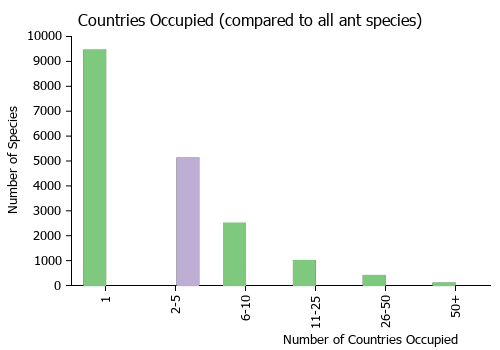Pheidole simplex
| Pheidole simplex | |
|---|---|
| Scientific classification | |
| Kingdom: | Animalia |
| Phylum: | Arthropoda |
| Class: | Insecta |
| Order: | Hymenoptera |
| Family: | Formicidae |
| Subfamily: | Myrmicinae |
| Tribe: | Attini |
| Genus: | Pheidole |
| Species: | P. simplex |
| Binomial name | |
| Pheidole simplex Wheeler, W.M., 1925 | |
At Cuzco Amazónico, near Puerto Maldonado, Peru, Stefan Cover and John E. Tobin found a colony in terra firme forest, nesting in a rotten log. (Wilson 2003)
Identification
See the description in the nomenclature section.
Keys including this Species
Distribution
Poorly known; records are from Amazonian Brazil and Peru. (Wilson 2003)
Latitudinal Distribution Pattern
Latitudinal Range: -2.687467° to -13.494733°.
| North Temperate |
North Subtropical |
Tropical | South Subtropical |
South Temperate |
- Source: AntMaps
Distribution based on Regional Taxon Lists
Neotropical Region: Brazil, Peru (type locality).
Distribution based on AntMaps
Distribution based on AntWeb specimens
Check data from AntWeb
Countries Occupied
| Number of countries occupied by this species based on AntWiki Regional Taxon Lists. In general, fewer countries occupied indicates a narrower range, while more countries indicates a more widespread species. |

|
Estimated Abundance
| Relative abundance based on number of AntMaps records per species (this species within the purple bar). Fewer records (to the left) indicates a less abundant/encountered species while more records (to the right) indicates more abundant/encountered species. |

|
Biology
Castes
Nomenclature
The following information is derived from Barry Bolton's Online Catalogue of the Ants of the World.
- simplex. Pheidole biconstricta subsp. simplex Wheeler, W.M. 1925a: 21 (s.) PERU. Raised to species: Wilson, 2003: 148.
Unless otherwise noted the text for the remainder of this section is reported from the publication that includes the original description.
Description
From Wilson (2003): Distinguished from other members of the biconstricta group by the dense, long, suberect to erect pilosity and reduced propodeal spines in both the major and minor castes. Also, only the anterior half of the first gastral tergite is shagreened and opaque.
MEASUREMENTS (mm) Lectotype major: HW 1.42, HL 1.36, SL 0.92, EL 0.16, PW 0.68. Paralectotype minor (Aleixo, Brazil): HW 0.64, HL 0.74, SL 0.90, EL 0.14, PW 0.44.
COLOR Major and minor: yellowish red, with gaster of minor a slightly contrasting brownish yellow.
Figure. lectotype, major (PERU: “Llinquipata”). Lower: minor (BRAZIL: Aleixo, near Manaus), compared with paralectotype from type locality. Scale bars = 1 mm.
Type Material
PERU: “Llinquipata”. Naturhistoriska Riksmuseet and Museum of Comparative Zoology - as reported in Wilson (2003)
Etymology
L simplex, simple, anatomical reference unknown. (Wilson 2003)
References
- Wilson, E. O. 2003. Pheidole in the New World: A dominant, hyperdiverse ant genus. Harvard University Press, Cambridge, MA. (page 148, fig. Raised to species: new status)
- Lubertazzi, D. 2019. The ants of Hispaniola. Bulletin of the Museum of Comparative Zoology, 162(2), 59-210 (doi:10.3099/mcz-43.1).
- Varela-Hernández, F., Medel-Zosayas, B., Martínez-Luque, E.O., Jones, R.W., De la Mora, A. 2020. Biodiversity in central Mexico: Assessment of ants in a convergent region. Southwestern Entomologist 454: 673-686.
- Wheeler, W. M. 1925a. Neotropical ants in the collections of the Royal Museum of Stockholm. Ark. Zool. 17A(8 8: 1-55 (page 21, soldier described)
References based on Global Ant Biodiversity Informatics
- Escalante Gutiérrez J. A. 1993. Especies de hormigas conocidas del Perú (Hymenoptera: Formicidae). Revista Peruana de Entomología 34:1-13.
- Fernández, F. and S. Sendoya. 2004. Lista de las hormigas neotropicales. Biota Colombiana Volume 5, Number 1.
- Kempf, W.W. 1972. Catalago abreviado das formigas da regiao Neotropical (Hym. Formicidae) Studia Entomologica 15(1-4).
- Wheeler W. M. 1925. Neotropical ants in the collections of the Royal Museum of Stockholm. Arkiv för Zoologi 17A(8): 1-55.
